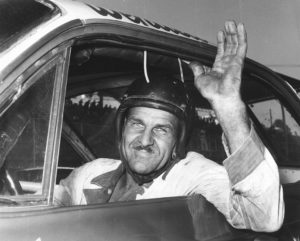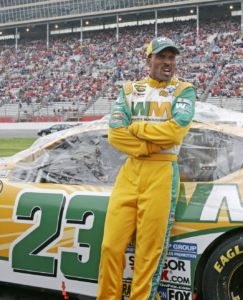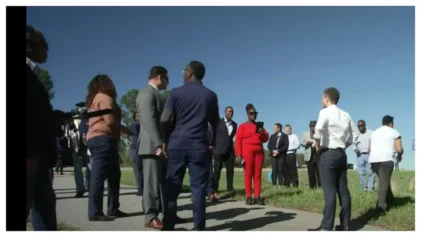
JACKSONVILLE, FL – DECEMBER 1: Wendell Scott won only one NASCAR Grand National race during his 40-plus year career. His lone victory came in the 200-mile event at Jacksonville Speedway in Jacksonville, Florida on December 1, 1963. (Photo by ISC Archives via Getty Images)
It’s been nearly 46 years since the world of NASCAR saw a full-time African-American driver at the wheel, but all that is about to change.
Rookie driver Darrell “Bubba” Wallace, Jr., is set to drive the iconic No. 43 car for Richard Petty Motorsports next season, making him the first full-time Black driver in the NASCAR Cup Series since Hall of Famer Wendell Scott back in ’71, RPM officials announced late last month. The 24-year-old, slated to replace driver Aric Almirola, is the lone Black face in a sport long-dominated by white men and revered by fans across the Deep South.
“There’s only 1 driver from an African-American background at the top level of our sport … I am the one,” Wallace tweeted. “You’re not gonna stop hearing about ‘the Black driver’ for years. Embrace it, accept it and enjoy the journey.”
Wallace’s upgrade to the driver’s seat is a welcomed change, considering the sport has not always opened its arms to embrace people of color. With a “bread and butter” fanbase that is nearly 60 percent male, 80 percent white and mostly from the Southern and Midwestern states, NASCAR’s dark history of racism and bigotry should come as no surprise. However, racial barriers failed to keep a few noted African-Americans from leaving their mark on the sport.
The poignant, and often untold history of Blacks in NASCAR started with Virginia native Wendell Scott, the sport’s very first African-American driver. Not only was Scott the first Black driver to hit the track, he was, by far, the most successful Black American to touch the sport, snagging a first place win at the Grand National Series race (NASCAR’s highest level) in December 1963. He went on to start a total of 495 races in NASCAR’s top series from 1961 through 1973, according to ThoughtCo., but his success didn’t shield him from discrimination both on and off the track.
Jim Crow laws barred Scott from racing at certain speedways at the time, and he even received death threats warning him not to come to Atlanta, his son, Franklin Scott, told StoryCorps in 2016. He said the bigotry and intimidation wasn’t enough to keep his father off the track, but there was one incident that left him feeling slighted.
“I remember him racing in Jacksonville, Fla. [at the Grand National Series], and he beat ’em all,” Franklin Scott recalled. “But they wouldn’t drop the checkered flag. When they finally did drop the flag, they had my father in 3rd place.”
One of the main reasons they had, he explained, was that there was a white beauty queen who always kissed the winning driver. Scott eventually received his prize money and was named the real winner of the race. By then, however, the crowd, trophy and beauty queen were all gone.
“Did he ever consider not racing anymore? Never,” Franklin Scott said. “That was one of my daddy’s sayings; ‘when it’s too tough for everybody else, it’s just right for me.’ ” His father continued racing until 1973.
NASCAR didn’t see another Black driver until 1986 — motorist Willy T. Ribbs. Ribbs started three races that year, including his first at North Wilkesboro Speedway in South Carolina on April 20, 1986. He was the first African-American to test a Formula 1 car in ’95 and the first Black driver at the Indy500 in ’91, auto enthusiast website Road & Track reported. Despite his success and support from notable figures like Bill Cosby and Paul Newman, the race-car driver’s time with NASCAR was short-lived. The talent and opportunity were there — but he just didn’t have the “right” support.
“The minority base in the United States is growing, but not with the racing community,” he said in an interview with the website. “They wanna keep the neighborhood looking the way it always has. You just hope they realize what they’re missing before it’s too late.”
Ribbs also blasted NASCAR for what he considers a lack of effort on their part to recruit the next generation of Black drivers. The sport launched its Drive for Diversity program in 2004 in an effort to reach historically underrepresented groups through a series of internships, pit-training courses and driver programs with Rev Racing. So far, Ribbs thinks the program has failed to do its job.
“NASCAR … as far as their diversity program is concerned, it’s a scam,” he said. “And what are other racing disciplines doing? IndyCar? Nothing. All of the major-league sports in this country, from baseball to football to basketball, there’s a beginning stage—an outreach—to get minority kids interested. There is none of that in racing.”
Bobby Norfleet, the first Black driver to compete in the NEXTEL Cup series in 2006, also struggled with the lack of diversity in the sport. For him, the issue was finding companies willing to sponsor a Black driver.
“We still didn’t understand sponsorships,” he told the Suffolk News-Herald of his self-titled racing team, Norfleet Motorsports, back in 2005. “About 75 percent of it was inexperience. I’d make 75 phone calls a day, and if one person said ‘Maybe,’ it was a good day. We would ask and get sponsors, and tell other teams, and then other teams would come in and take our sponsors.”
Norfleet eventually earned the support of Black celebrities and companies like songstress Gladys Knight, 40 Street Records, So So Def Records, LaFace Records, Ron Winan’s Chicken and Waffles and RDJ Entertainment-Florida. Altogether, they helped rake in millions for the team, as Norfleet geared up to make his debut on the truck circuit in ’95, according to the newspaper. He stayed there five years before making it to the Craftsman Truck Series in at the Dodge California Truckstop 250 in March 2000.
In his short career (which ended in 2006), Norfleet acknowledged that the sport had made progress in diversifying its workforce. He wasn’t talking about drivers, however.
“I’ve seen true diversity in NASCAR,” he said. “The last few years, I’ve seen more Black executives. When I started, there weren’t any.”
His daughter Tia Norfleet would stand to carry on the legacy of Black NASCAR drivers in 2013, but that all came crashing down when racing officials determined that she’d been lying about her stature in the sport. Tia had promoted herself as an accomplished driver who was working her way to become the first African-American female NASCAR driver. A New York Times report revealed, however, that the younger Norfleet wasn’t even licensed to compete in NASCAR’s top tier series and that the only sanctioned race she had entered was a low–level event.

NASCAR driver Bill Lester poses with his car before the Golden Corral 500 NASCAR race at Atlanta Motor Speedway in Hampton, Georgia, March 19, 2006. (Photo by Mike Zarrilli/Getty Images)
Another Black driver who left his mark on the sport was Bill Lester, joining the ranks of drivers like Scott and Ribbs after racing in the NASCAR Cup Series back in 2006. He was the last African-American driver to do so before Wallace stepped on the scene.
During an interview with CNN’s Brooke Baldwin in September, Lester recalled how he was not embraced by the racing community despite his success, much like the handful of Black drivers who came before him. The discussion soon turned to President Donald Trump’s call for NFL team owners to fire players who dared kneel during the national anthem to protest racial injustice, an effort sparked by ex-San Francisco 49ers quarterback Colin Kaepernick last year.
Unsurprisingly, several NASCAR owners like Hall of Famer Richard Petty sided with the President and threatened to fire any driver who participated in the protests. Lester expressed disappointment with the owners’ ultimatum, but wasn’t all that surprised because, “Those that are in NASCAR – that’s a culture. These drivers … they know each other, they all have common beliefs, bonds, culture, and so yeah, they’re all pretty much peas in a pod.”
He went on to describe the times he was heavily booed during races in the Deep South, specifically at Alabama’s Talladega Superspeedway and in Martinsville, Va. He said he’d “never been so uncomfortable in a racing environment” as he was in those.
“It was surprising to me because I think that I did a great job behind the wheel,” Lester told Baldwin. “I think that I respected the sport, but for no reason that I can foresee, I was booed. So that happened mostly at tracks where it’s very non-progressive.”
Lester’s racing career spanned nine years, ending in 2012. The year before his departure, he earned 6 Top 5 and 5 Top 10 finishes from all 12 races with the Rolex Grand-Am Grand Touring class and won the race at Virginia International Raceway on May 14th.
Black Americans weren’t only making gains on the track, but in the pit too. Twenty-three-year-old Brehanna Daniels recently made history as the first African-American woman to pit a vehicle in a national NASCAR series race, espnW.com reported.
NASCAR has made little racial progress recent decades and it still has a long way to go when it comes to better representing nonwhite racers. The sport’s unwillingness to let go of Confederate and Old Dixie imagery says a lot about the current state of affairs, as well.
With the torch now in Wallace’s hands, Lester offered him these words of advice: “focus on racing and ignore the haters.”


